1 Provenience. Described above. The 203 Krasny Yar pieces represent 2.3% of our 8813-piece grand total (Table A1.1, site 12).
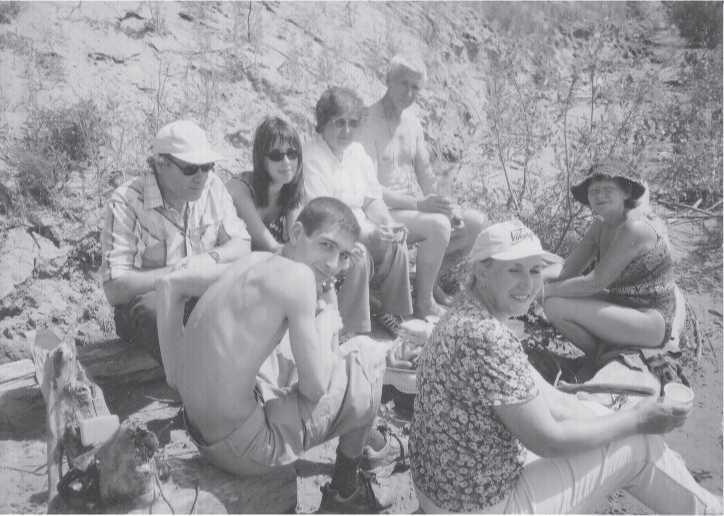
Fig. 3.49 Participants of the Krasny Yar visit. Clockwise from the top: Nicolai Ovodov, Olga Pavlova (dark hat), Irina Foronova, student, Vlamir Zykin, student, L. Orlova (CGT color Krasny Yar 7-7-00:25).
2 Species. The most common species identified in the 203 Krasny Yar pieces are: elk (26.6%), horse (18.2%), small deer (7.9%), lion (7.9%), bear (7.4%), wolf (6.4%), bison (5.9%), beaver (5.4%), saiga antelope (4.4%), big deer (3.9%), reindeer (3.0%), and rhinoceros (3.0%) (Table A1.2, site 12). Compared with the pooled assemblage averages, Krasny Yar has more bear, beaver, bison, big deer, small deer, elk, horse, lion, rhinoceros, and wolf; fewer mammoth and reindeer; no big mammal, Capra, gazelle, goat-sheep, hyena, roe deer, and indeterminable. The high degree of specific identification in Krasny Yar has two explanations: First, completeness at Krasny Yar is especially high, even for a paleontological site. Second, Sergei Vasiliev, in consultation with Nicolai Ovodov, has spent several years studying this assemblage for his dissertation, so a lot of time has been spent on identification and classification.
3 Skeletal elements. The most common elements in the 203-piece Krasny Yar assemblage are: mandible (30.0%), metapodial (15.3%), humerus (12.8%), tibia (7.9%), radius (5.9%), vault (4.4%), and femur (4.4%) (Table A1.3, site 12). These frequencies do not take into account a large number of foot bones we did not score because they had no identifiable perimortem damage other than polishing. Compared with the pooled assemblage averages, Krasny Yar has more pieces of vault, mandible, humeri, tibia, and metapodial; fewer vertebrae and ribs; and no long bone and unknown elements.
4 Age. Out of 203 Krasny Yar pieces, 6.4% belong to sub-adults (Table A1.4, site 12). Compared with the pooled assemblage average, Krasny Yar is very similar; however, it has about 30% more positively identified adults than the pooled assemblage.
5 Completeness. Bone preservation in a buried aquatic context is often very good. Krasny Yar is no exception. Out of the 203-piece assemblage, 23.2% are whole, 58.6% have one anatomical end, and only 18.2% have no anatomical ends (Table A1.5, site 12). Compared with the pooled assemblage averages, Krasny Yar is clearly more complete: 10.9% whole, 30.0% one end, 59.1% no ends.
6 Maximum size. Piece size correlates with completeness, as the Krasny Yar mean (19.7cm) and range (3.1cm to 43.5 cm) readily demonstrate (Table A1.6, site 12). Compared with the pooled assemblage size average (9.0 cm), the Krasny Yar mean is twice as big. Nevertheless, there is considerable piece size reduction. This can be appreciated by comparing the Krasny Yar maximum size values with the ranges for undamaged long bone length provided by Vera Gromova (1950: table 27). In the cases of the most common species found at Krasny Yar (elk, horse, lion, bear, bison), the mean piece size is less than the lower end of the ranges of all five species’ major long bones.
7 Damage shape. This variable was not scored in the Krasny Yar assemblage due to its entirely different aquatic taphonomy, where most of the bone alteration was likely related to water transport.
8 Color. The majority (53.5%) of the 202 Krasny Yar pieces are brown in color, presumably due to water-borne stain. Only 36.1% are ivory colored. The black colored pieces are not due to burning - the cause is a very dark surficial stain of an unknown substance (Table A1.8, site 12). Compared with the pooled assemblage averages, Krasny Yar has half the frequency of ivory colored pieces, and five times more brown colored pieces. Was it a mineral-rich groundwater setting that is the common factor to the assemblages that have a frequent occurrence (>20%) of brown colored bone?
9 Preservation. Unlike other open sites in our study, Krasny Yar has a high frequency of ivory hard pieces (194/203; 95.6%) (Table A1.9, site 12). Compared with the pooled assemblage average, Krasny Yar is significantly higher in quality.
10 Perimortem breakage. Out of 196 Krasny Yar pieces, 60.3% have perimortem breakage (Table A1.10, site 12). Compared with the pooled assemblage average, Krasny Yar has much less perimortem breakage. Presumably this is due to the near absence of identifiable carnivore and human processing.
11 Postmortem breakage. Like our other open sites, the 200 Krasny Yar pieces exhibit considerable postmortem breakage (38.5%) (Table A1.11, site 12). Weathering on the ground surface before burial, and subsequently after re-exposure, are the main reasons. Compared with the pooled assemblage average, Krasny Yar has twice as much postmortem breakage.
12 End-hollowing. This variable is surprisingly fTequent in the 185 Krasny Yar pieces (30.8%) (Table A1.12, site 12). Compared with the pooled assemblage average, Krasny
Yar has significantly more end-hollowing. At first we thought all this end-hollowing must have been caused by water transport, but our scores for other presumed carnivore indicators are equally frequent. The only conclusion that makes taphonomic sense is that, indeed, carnivores had chewed on some of the carcasses at times and places at Krasny Yar and possibly also up-river when the dead animals still possessed some degree of edible tissue or bone marrow. Given the open bone bed context of Krasny Yar, we should also allow that some of the “carnivore” damage could have been done by bone-chewing, mineral-seeking herbivores.
13 Notching. There is considerable notching inthe 200 Krasny Yar pieces (18 / 200; 9.0%). The number of notches per notched piece ranges fTom one to six (Table A1.13, site 12). Compared with the pooled assemblage average (14.9%), Krasny Yar has somewhat less notching.
14 Tooth scratches. Tooth scratches are correlated with notching, and the 31.3% scratched pieces in 195 Krasny Yar pieces is no exception. The number of scratches per piece ranges from one to more than seven, with the latter being the largest of the scratched groups (11.8%) (Table A1.14, site 12). Compared with the pooled assemblage average, Krasny Yar has considerably more pieces with tooth scratching.
15 Tooth dints. Dints are also correlated with notches as well as tooth scratches. The 24.7% dinting in 194 Krasny Yar pieces meets this expectation. The number of dints ranges from one to more than seven, with the latter being the largest class (8.8%) (Table A1.15, site 12). Compared with the pooled assemblage average (25.6%), Krasny Yar is nearly the same.
16 Pseudo-cuts. This condition was judged to have occurred in 5.5% of 200 Krasny Yar pieces. The number of pseudo-cuts per piece ranges from one to four, with one pseudo-cut per piece being the largest class (3.5%) (Table A1.16, site 12). Compared with the pooled assemblage average, Krasny Yar has very nearly the same frequency of pieces with pseudo-cuts.
17 Abrasions. Given the riverine depositional setting, we expected to find a high frequency of abrasions, or at least randomly distributed striations. Such was not the case. In the 201 Krasny Yar pieces, abrasions occurred in only 1.5% of the assemblage, all being more than seven in number (Table A1.17, site 12). One ofthese pieces has more than 100 abrasion striations. Compared with the pooled assemblage average, Krasny Yar is almost exactly the same.
18 Polishing. If abrasions did not meet our expectations, then polishing did, because 93.0% of the 200 Krasny Yar pieces are polished. End-polishing occurs in 5.5%, middle in 3.0%, and middle-end in 84.5% of the assemblage (Table A1.18, site 12). Compared with the pooled assemblage for total polishing, Krasny Yar has considerably more. Because there are other sites in this study with large amounts of polishing - for example Varvarina Gora (96.0%) - which we attribute to carnivore and/or human processing, the question that soon arose in our examinations was: What caused the Krasny Yar polishing? Was it mainly water/sand abrasion? Was it mainly carnivore? Was it both? Unfortunately, we never found a way to answer these questions.
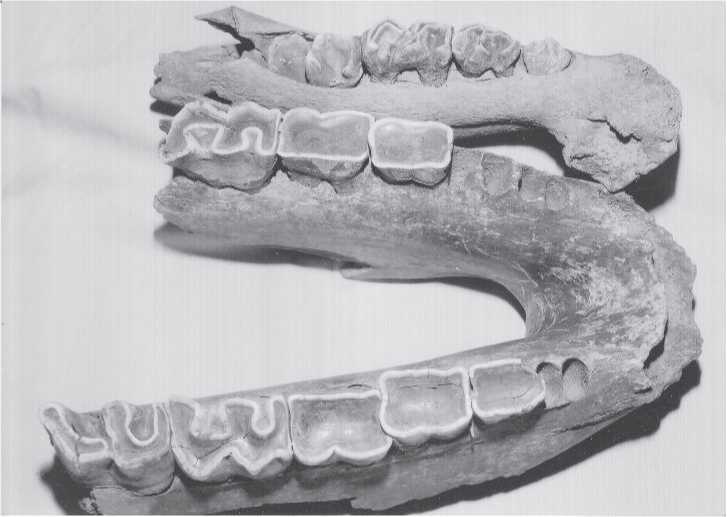
Fig. 3.50 Krasny Yar animals. Mandibles of an old wooly rhinoceros (Coelodont) and a sub-adult (top). The adult jaw is 27.0 cm in length. Breakage appears to be postmortem (CGT neg. IAE 6-21-00:29).
19 Embedded fragments. Out of 203 Krasny Yar pieces, 1.5% have 1-3 embedded fragments (Table A1.19, site 12). Compared with the pooled assemblage average, Krasny Yar has fewer pieces with embedded fragments.
20 Tooth wear (Figs. 3.50-3.57). Krasny Yar has the largest tooth wear sample size in our study. Of the 54 specimens, we judged 20.4% to be young individuals at the time of their deaths (Table A1.20, site 12). Compared with the pooled assemblage average for young individuals, Krasny Yar has about half the number. Since we feel that this study has identified so many factors that influence the occurrence or non-occurrence of young individuals in our various contexts, we have no way to tell whether one interpretation of this difference is better than any other. We can be certain that transport and time on the surface (Fig. 3.58) contributed to survivorship as illustrated and discussed in Chapter 2 (small calf vs. large bull).
21 Acid erosion. Of the Krasny Yar pieces, 203 were evaluated for acid erosion. Not a single specimen was identified (Table A1.21, site 12). At issue here is differential survival between large and small pieces of bone and teeth in a high-energy riverine context, as well as differential beach collecting without the aid of screens. We feel that both factors have influenced the size survivorship and related taphonomic characteristics of the Krasny Yar assemblage, probably more so than even in other sites where screening had been minimal. In any event, it was our expectation that one or two acid-eroded pieces would show up in the collection because of the carnivore
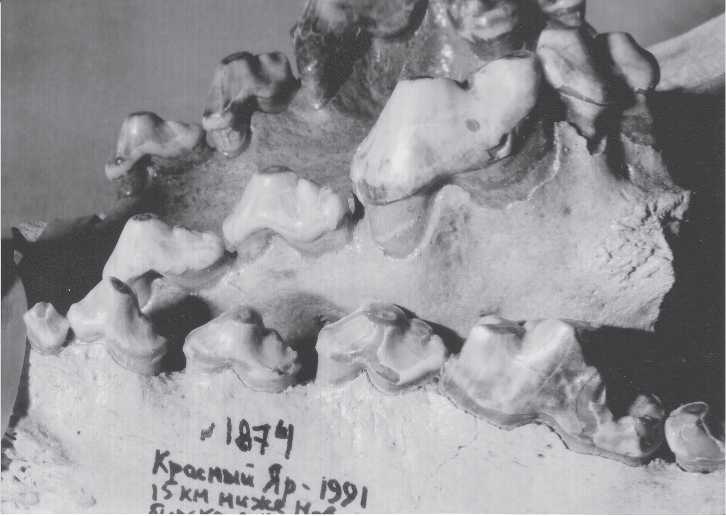
Fig. 3.51 Rrasny Yar animals. Wolf (Canis lupus) jaws illustrating cusp wear pattern with tips worn flat.
These flat surfaces have sharp chisel-like borders that under some conditions could act like a burin. It is believed that carnivore teeth with this sharp-bordered cusp tip wear were responsible for some of the pseudo-cuts (CGT neg. IAE 7-8-02:7A).
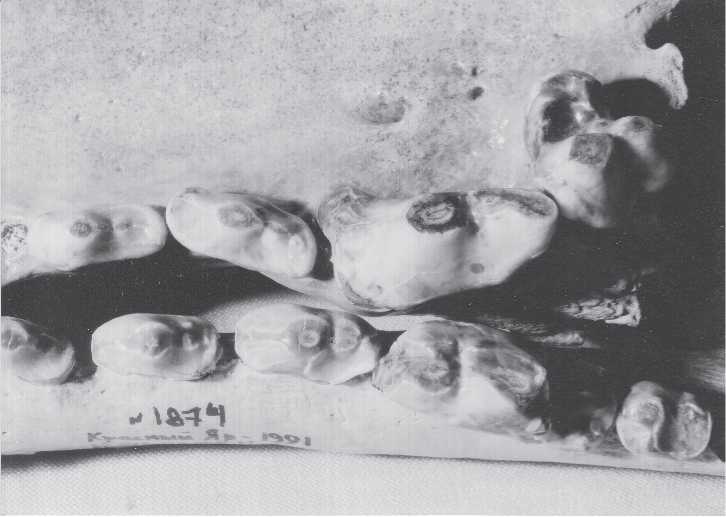
Fig. 3.52 Krasny Yar animals. Another view of wolf tooth wear to show the flat wear on the cusp tips and the associated sharp borders (CGT neg. IAE 7-8-02:5A).
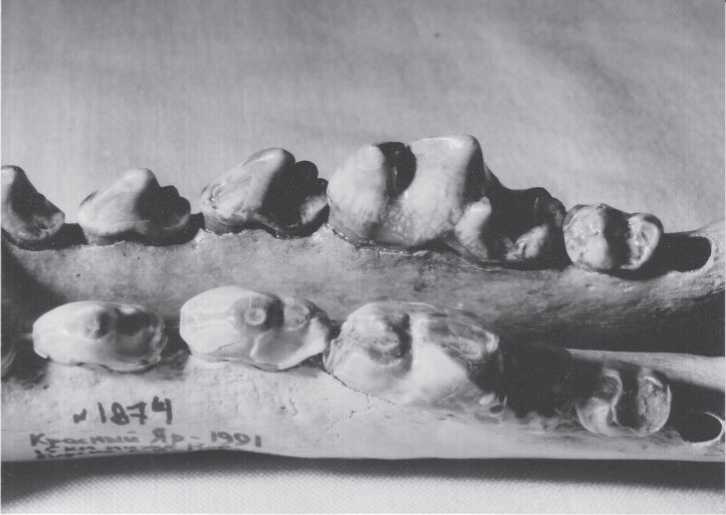
Fig. 3.53 Rrasny Yar animals. A final example of wolf tooth cusp tip wear in an older animal (bottom) in contrast to absence of wear in a sub-adult (top). The unworn teeth do not have the chisel-like cusp tips (CGT neg. IAE 7-8-02L:11A).
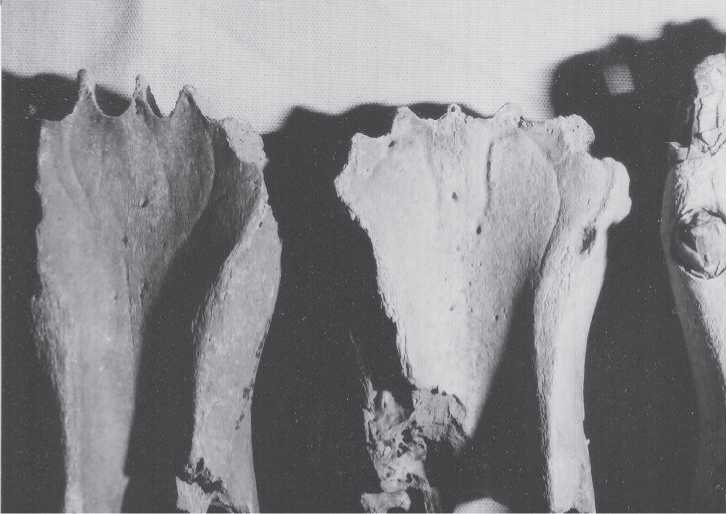
Fig. 3.54 Krasny Yar animals. Horse mandibles showing variation in the occurrence of a canine tooth.
Breakage caused by tumbling, ice, or other mechanical means. There are no signs of carnivore damage. Almost all of the Krasny Yar bone damage was mechanical (CGT neg. IAE 6-20-00:3).
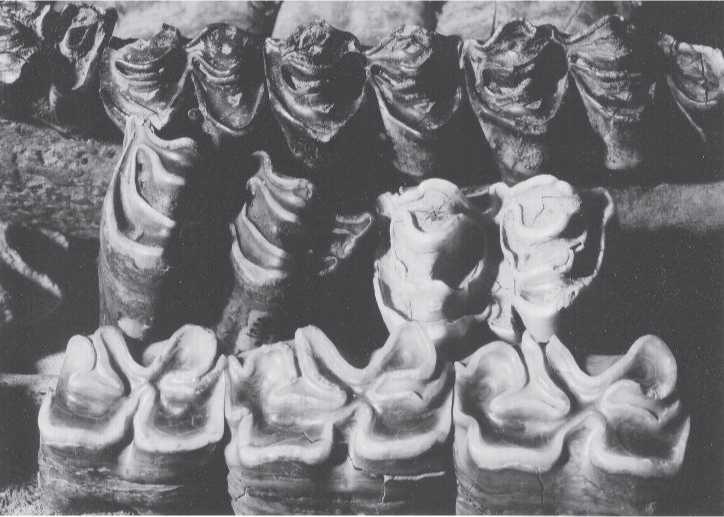
Fig. 3.55 Rrasny Yar animals. Teeth of Equus (bottom), Bison (middle), and Cervus (top) are abundant at Rrasnoi Yar. Tooth breakage is minimal, suggesting death site and burial site may not have been far apart. Although depositional rates may never be calculated for this site, the abundance of herding animals of large size suggests game was available, if not abundant, for human hunters and carnivores alike. Nevertheless, competition to make a kill, and then to retain the carcass, may have been keen (CGT neg. IAE 6-20-00:2).
Damage and the presence of actual hyena in the species inventory. Such was not the case.
22 Rodent gnawing. Like Boisman II, rodent gnawing is relatively common in the 204-piece Krasny Yar assemblage, amounting to 4.9%. This is much more ITequent than in the pooled assemblage (0.5%) (Table A1.22, site 12). We have no trouble imagining small rodents of the river, lake, or slough shore habitat scampering day or night throughout much of the year across, and occasionally gnawing on, the large bony carcasses partly buried here and there in the muddy banks of their resting places. Among all of our site contexts, that of Krasny Yar is intuitively best for rodent presence.
23 Insect damage. Like rodent damage, the contextual conditions we imagine existed at Krasny Yar, or shortly before the assemblage accumulated at Krasny Yar, could have also been beneficial for insect exploitation of the bony remains. This expectation seems realized since a very low but relatively high frequency of insect damage was identified for 203 pieces of the Krasny Yar assemblage (0.5%) (Table A1.23, site 12). The pooled assemblage average is similar.
24 Human bone. No human bone has been found at Krasny Yar.
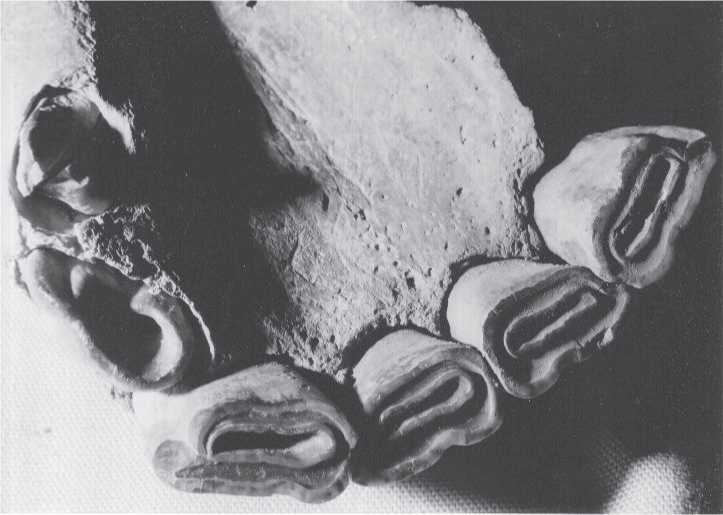
Fig. 3.56 Krasny Yar animals. Equus mandibular teeth showing no perceptible weather-cracking or other
Postmortem damage. This horse was buried shortly after the animal died. Presumably, all or most of the carcass floated to the Krasnoi Yar locality, where it was soon covered by silt and sand (CGT neg. IAE 6-20-00:9).
25 Cut marks. Two pieces (1.0%) out of 202 seem to have cut marks, the identification strengthened by the fact that both have more than seven incisions (Table A1.25, site 12). This frequency of cut pieces is much less than the pooled assemblage average, but given that Krasny Yar is a full-blown paleontological site, the occurrence of cutting is of no small interest relative to the Pleistocene prehistory of this open, flat region of Siberia. Both pieces are well preserved so they perhaps belong to Vasiliev’s younger group. One piece is a 6.7 cm long caribou metapodial fragment that has 15 cut marks and 11 abrasion grooves. It also has end-hollowing, four tooth scratches and ten tooth dints, making the cut marks suspect. The other piece is a 12 cm long fragment of a horse mandible with 16 cut marks. It lacks end-hollowing and tooth dints, but has one tooth scratch, making it also suspect but much less so than the caribou metapodial. Fossil ivory is much sought after for carving by Alaskan natives. Perhaps the two Krasny Yar cut pieces represent similar actions. There might be a few more cut pieces if the damage we judged to be pseudo-cuts actually were cut marks (Figs. 3.59-3.61).
26 Chop marks. There are no chop marks on any of the 202-piece Krasny Yar assemblage.
Figs. 3.62-3.66 illustrate damage by uncertain causes.
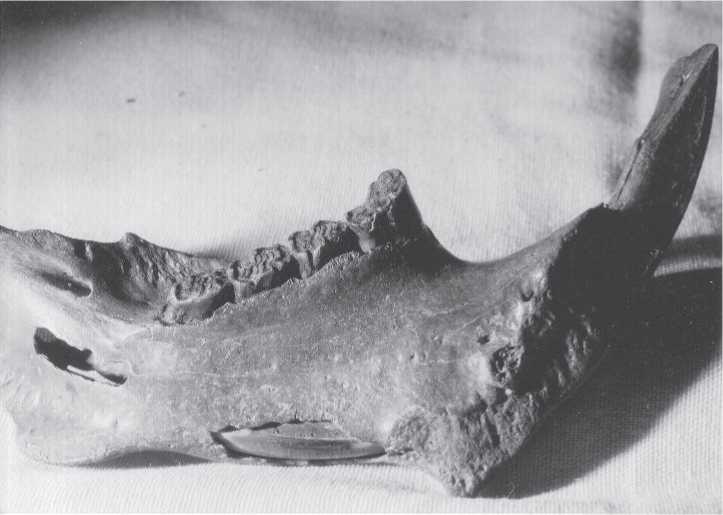
Fig. 3.57 Rrasny Yar animals. A beaver (Casterfiber) mandible. A stream with nearby trees, not the
Mighty Ob River, would be the expected habitat of this creature. It shows very little postmortem damage. What little there is exposed the unerupted portion of the incisor that runs nearly the entire length of the jaw. The jaw is 11.9 cm in length. Perhaps it floated to Krasny Yar from as far south as the Inya River or from one of the many sloughs and streams in between (CGT neg. IAE 6-20-00:18).
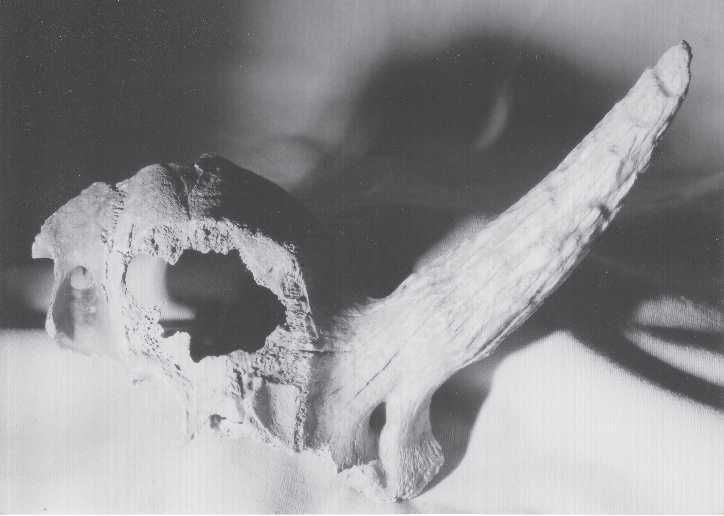
Fig. 3.58 Krasny Yar animals. The skull base and horn core of a saiga antelope shows considerable breakage and chewing on the horn core. It clearly had been exposed to scavengers before burial at Krasny Yar. Horn is 10.0 cm long (CGT neg. IAE 6-23-00:9).
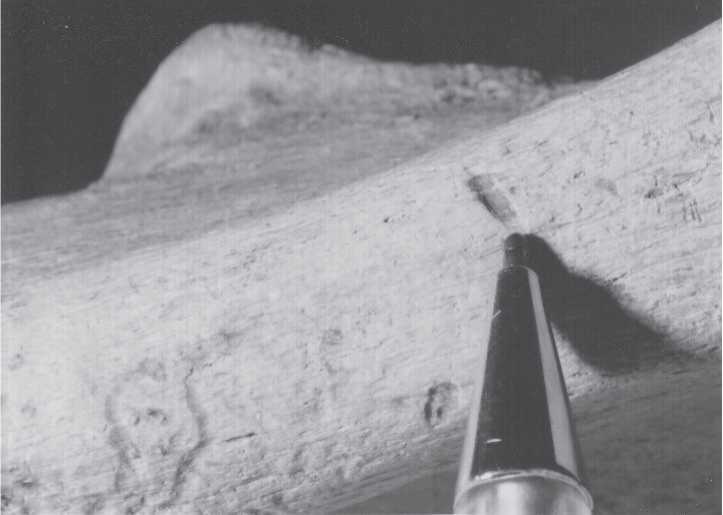
Fig. 3.59 Krasny Yar animals. Cave lion (Panthera spelaea) ulna with 0.3 cm long pseudo-cut at pencil point (CGT neg. IAE 6-23-00:10).
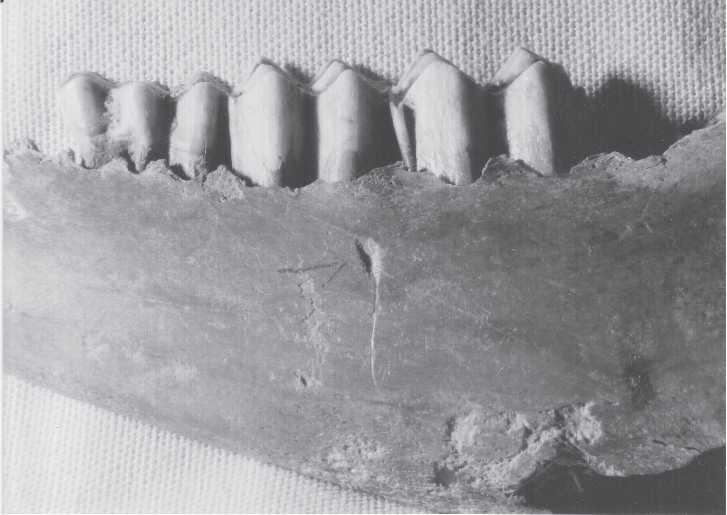
Fig. 3.60 Krasny Yar animals. Saiga antelope mandible with 0.3 cm long pseudo-cut near the alveolar border and chewing damage to the inferior border of the ramus (CGT neg. IAE 6-23-00:6).
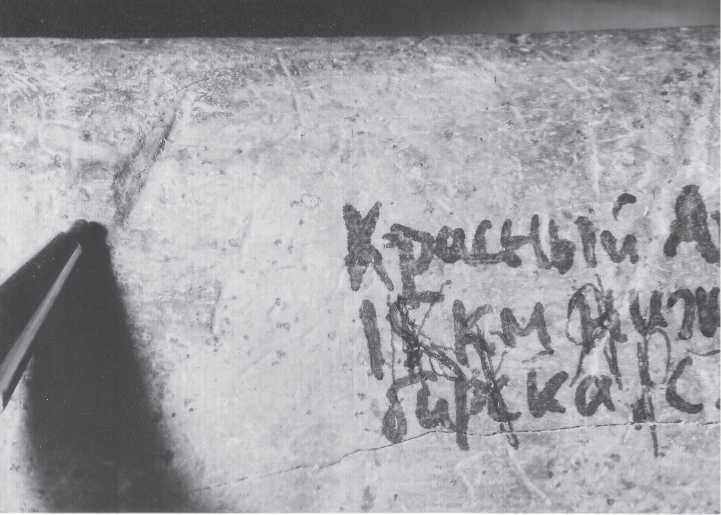
Fig. 3.61 Rrasny Yar animals. Pencil points to a 0.9 cm long pseudo-cut on a bear femur. Nearby tooth scratches are partly obscured by the lettering (CGT neg. IAE 6-21-00:23).
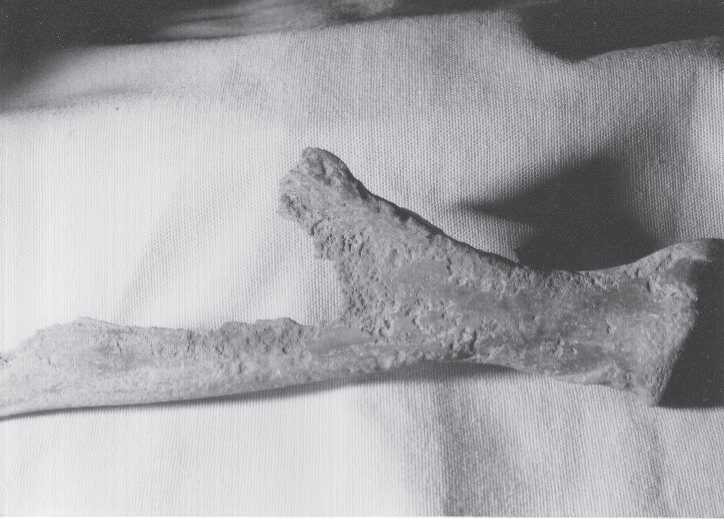
Fig. 3.62 Krasny Yar animals. A saiga antelope left scapula shows pitting and erosion damage to its internal surface. The cause is unknown. Some root damage is possible. Maximum length is 16.0 cm (CGT neg. IAE 6-23-00:5).
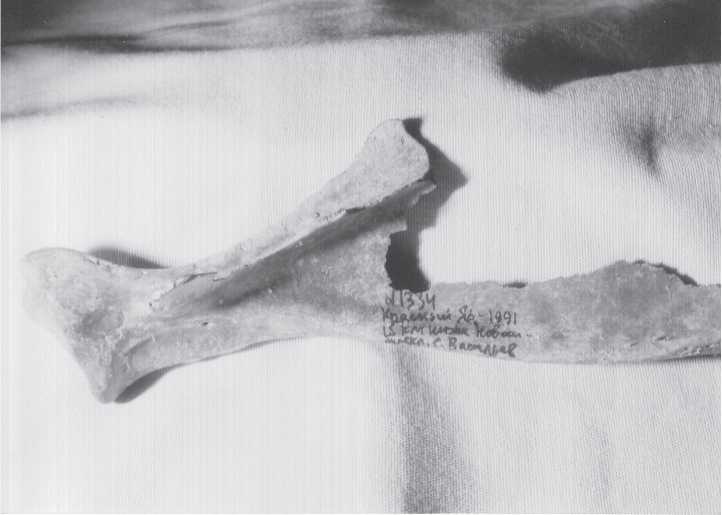
Fig. 3.63 Rrasny Yar animals. The external surface of the scapula shown in Fig. 3.62 shows no
Pitting or erosion. This peculiar difference was seen in many pieces of bone that had come from open sites (CGT neg. IAE 6-23-00:3).




 World History
World History









